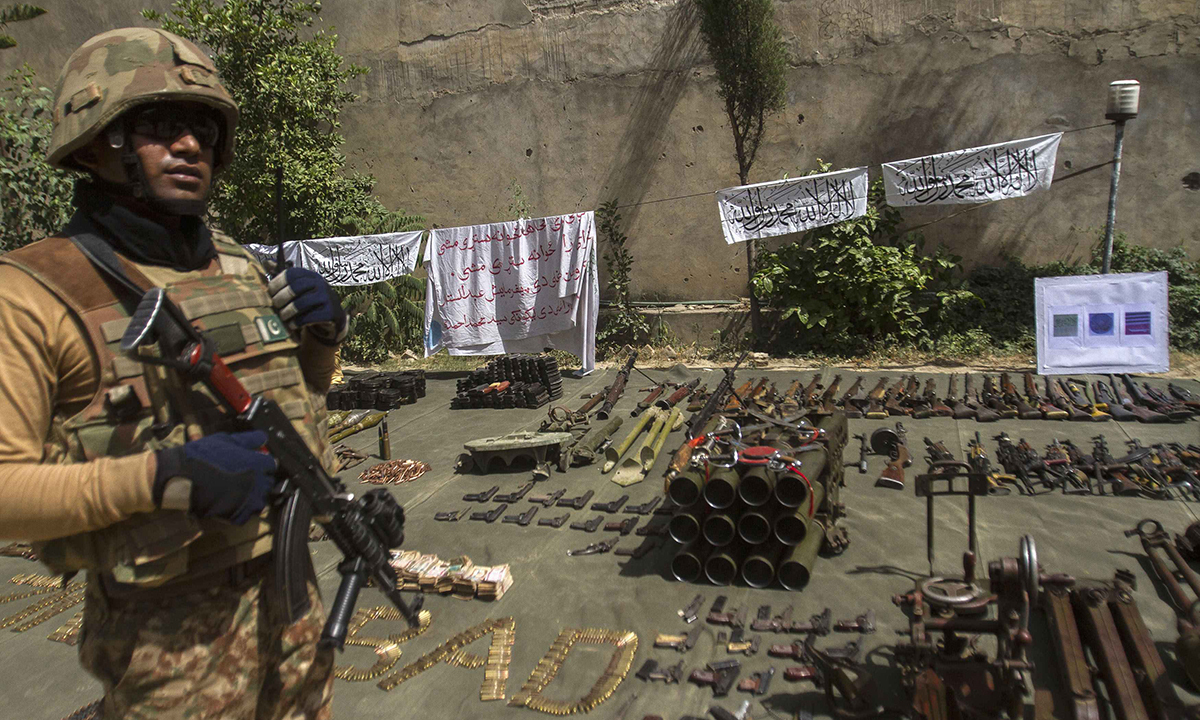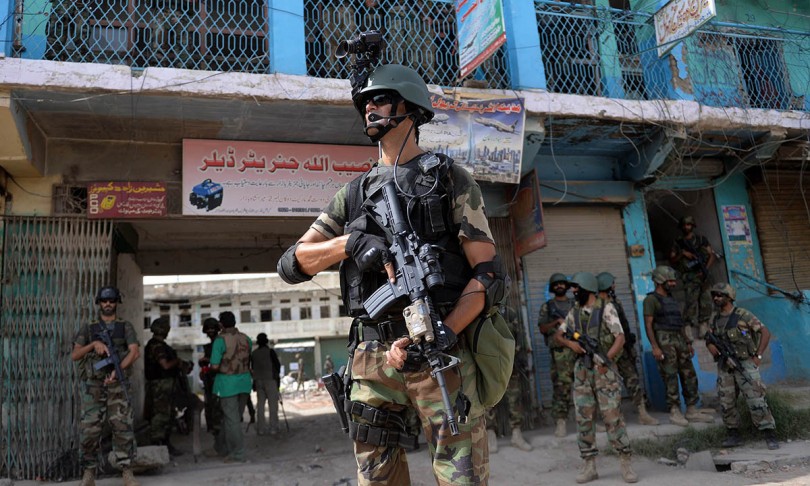A bomb blast in the interior of Sindh traumatized the beleaguered nation of Pakistan. Already the horrifying attack on school children by TTP militants in Peshawar on December 16, 2014 had sent shockwaves throughout the world. Recently the Pakistani fight against the TTP made serious headway with Pakistan getting custody of Latif Mehsud from Afghanistan. Earlier security forces in Baluchistan foiled a major terrorist attack ahead of Ashura. Coming on the back of the success in Operation Zarb-e-Azb, it looks as if the Pakistani counter militancy effort is making significant progress. Yet there have been lapses and breaches along with success. The appalling attack on Wagah is another such example. Yet this does not undo the entire advancement of the anti militancy struggle. As history shows such unconventional conflicts are parts of a long and hard struggle where “final” or comprehensive victory takes several years to achieve, a fact supported by the chief of U.S. Central Command in 2002. For more evidence we can observe in our own neighborhood the Sri Lankan struggle against the LTTE, popularly known as the Tamil Tigers, which lasted at least 25 years.
It is preferable to not use the term “terrorist” as the term is not value-free. As the famous saying goes “One man’s terrorist is another’s freedom fighter”; on top, the lack of a universal definition for terrorism makes it problematic to employ this term. Also the utilization of this term in government propaganda gives a notion of one sided bias.
More often than not, proxies, guerillas, militants, insurgents or likeminded groups work in a similar fashion. It is crucial to formulate a phased approach, detailing the stages of progress or regress of militant organizations.
To assess the situation and its remedy, it is essential to analyze the functioning of militant non state actors and the powers that support them. More often than not, proxies, guerillas, militants, insurgents or likeminded groups work in a similar fashion. It is crucial to formulate a phased approach, detailing the stages of progress or regress of militant organizations. These phases then can be used later on, as benchmarks to analyze at which juncture the militant organizations have reached, as well as a basis on which to devise appropriate countermeasures.
- PHASE 1: This stage usually deals with the formation and initiation of militant groups. Militant groups gravitate around ideological bedrock which gives a pretext for their actions. It could be an ethno-national philosophy or more far reaching sociopolitical belief like Marxism or violent fundamentalism. The low level foot soldiers could be allured by such beliefs as well as factors like social deprivation and disillusionment with the current sociopolitical order acting as catalysts. The upper tiers of such organizations could be an ideologically motivated group or individuals driven by congruent interests or a mix of both. Foreign handlers with strategic imperatives in mind can participate in a critical manner by acting as stimulants in addition to providing material and technical support.
- PHASE 2: After formation, militants would start functioning by engaging in activities like guerilla warfare, bomb attacks, assassinations, hostage taking, extortion, cyber attacks, targeting of national monuments etc. The scope of militant actions is limited by the amount of manpower and material available to the group. Such acts usually act as a tool to “advertise” the group by means of showcasing its existence and capabilities. Usually groups in this stage, wages hit-and-run attacks from safe havens outside the state, with which they are at war. Mostly these safe havens are provided by a foreign power. This helps the group evade retaliatory action from the target state.
- PHASE 3: After the attacks help the groups reach a suitable threshold, they move to the next stage by establishing strongholds on the enemy’s territory from which the non state actors intensify their operations against the rest of the state. They seldom try to take over entire countries; their target is only those parts where the state’s writ is weak. These strongholds help group recruitment efforts as well as providing internal safe havens.
- PHASE 4: The fulfillment of the previous phase gives rise to a variety of options to the group and their foreign backers. They could both consolidate their gains and use them as leverage during negotiations with the enemy state or they could separate their captured area from the enemy state. They can also consider enlarging their localized insurgency into a country-wide civil war. Here most ethno nationalist organizations are typically at a disadvantage as compared to militants espousing transnational or interethnic ideologies like Marxism or religious fundamentalism.
The greatest challenge comes in the first phase when the enemy is out of reach of the state and a “war of shadows” has to be waged to degrade the enemy and prevent further attacks.
It is at the second phase, in which, the militants are most weak and strong at the same time; strong in the sense that they have a foothold in the enemy territory and weak because they have to use conventional warfare against an enemy which is more powerful, and enjoys conventional superiority. If the groups face defeat here they are more often than not pushed back to phase one; that is, if their foreign employer is not discouraged of their future usefulness.
Most countries succeed at Phase Two where they are fighting on their home turf and utilizing their superior conventional military might to crush the enemy. The greatest challenge comes in the first phase when the enemy is out of reach of the state and a “war of shadows” has to be waged to degrade the enemy and prevent further attacks. Here, the counter-intelligence and counter-terrorist activities play the main role. Counter insurgency is utilized in phase two, and is generally unable to provide the finishing blow to the target non state actor. Important examples are the Iraq and Afghanistan occupation by the West as well as the conflict between the USA and the Vietcong. A noteworthy exception to this rule would be the Sri Lankan victory over the LTTE in 2009. However two factors went in favor of the Sri Lankan government; the geography, and the fact that the foreign backer of the LTTE, India, had turned against them. Furthermore the Sri Lankans faced a single unified force in its civil war.
Pakistan’s struggle is much different. It faces a variety of enemies sometimes allied across a variety of elements. It faces an ethno nationalist revolt in the form of Baluch, and to a minute extent Sindhi separatists, as well as misguided “religious extremists” in the form of the TTP, Lashkar-e-Jhangvi, Al Qaeda, Sipah-e-Muhammad etc. It also faces fighting between militant wings of political parties in its main seaport and commercial centre of Karachi.
The current wave of militancy seems to be in its last throes due to infighting, successful operations by the security forces and overtures by the federal government.
The first type of insurgency has largely been limited to a small number of areas, mainly inner Baluchistan. Most of the activities have been limited to target killing of both Baloch and non-Baloch non combatants, small scale attacks on security forces, IED attacks, kidnappings, extortions, bombing of installations & landmarks and other low level activities. While the Army has been used on some occasions in the past, recently the police and paramilitary organizations like the Frontier Corps have been used to deal with this threat. While the conflict has erupted nearly four times since the independence of Pakistan, the current wave of militancy seems to be in its last throes due to infighting, successful operations by the security forces and overtures by the federal government.
The second militancy mainly under the aegis of the TTP, although more recent than the Baluchistan separatist terrorism, has been more troubling for the state. While the Baluch separatists have been limited to some areas, the TTP had not only made strongholds in the Tribal areas of FATA but also have well entrenched cells in the densely populated metropolises in the rest of the country. Conceivably, this is the factor which gives them the capacity to wage well coordinated and devastating attacks in the rest of the country. Also while the Baluch separatist interests are largely related to Baluchistan, the TTP and its affiliates wish to overthrow the Pakistani state and replace it with their own government.
Apparently, the TTP were at Phase two. However, strong measures by the state which were a mix of COIN, political measures as well as espionage have helped weaken the militancy as well as to deprive them of their last strongholds. The infighting that emerged between the TTP after the death of its leader Hakeemullah Mehsud has helped the TTP disintegrate, in addition to the surrender of its various groups. The TTP leadership has now fled to Afghanistan and is making new hideouts, having been pushed back to Phase One. However the reports of their demise are apparently premature.
The TTP has several cells operating in the country like in Karachi as well as splinter groups like Ahrar-ul-Hind. Now, as the enemy has been pushed back to Phase one, massive counter-insurgency operations like Operation Zarb-E-Azb , will not be as effective as they previously were. The need of the time now will be to improve counter intelligence efforts to avert attacks as well as destroy these cells. Counter intelligence efforts are mostly dependent on local law enforcement and it is this area where the state is seriously lacking. The Pakistani police are notorious for being corrupt and inefficient and largely the blame for this falls on the politicians. Instead of forming a force to maintain law and order, sadly political governments have used the police as a tool to pursue their own agenda. The replacement of the Karachi operation team is such an example that otherwise were performing amicably in curbing the TTP threat in Karachi.
While it is easy to blame militancy on warped religious teachings or sub nationalist feelings, in essence, militancy boils down to a ‘revenge psyche’. Individuals believe themselves aggrieved by the state and use violence to ‘settle the score’.
Such political interference has been a major reason in making the local law enforcement less effective while also giving valuable time to anti state and criminal elements to gain a respite from otherwise deadly pressure.
And this is not the only place where the political leadership is responsible; the miserable failure of the successive governments to provide the citizens of Pakistan with justice and economic opportunity has led to the frustration aggression principle to go full throttle. In many cases the internal failings of the government are more to blame rather than external interference by hostile neighbors.
However this cannot discount the significance of the impact of the support of foreign powers to militant non state actors. After all in Phase 1 these organizations are dependent above all else on their foreign benefactors. India which is considered to be the archrival of Pakistan has been known to use Afghanistan “as a second front to finance trouble for Pakistan”. Furthermore, the current security advisor to the Indian PM is Ajit Doval who wishes to “destroy Pakistan”. RAW has an affinity to utilize terrorists to do its bidding. It would not be prudent to limit foreign interference to India alone. Another of Pakistan’s neighbor Iran is, notorious for utilizing militant proxies. Its main focus for formation of militants is on members of the Shia community of which Pakistan has the second largest population per capita. Another foreign threat is the USA which has long standing relations with militant non state actors. Its footprint can already be found in the Afghan Mujahideen from whom the TTP claim descent. A CIA agent known as Raymond Davis was found to have links with the TTP. Such assistance would be a revitalizing agent for these beaten militants.
It is optimal to pursue a diplomatic course with all these foreign powers, specifically India, in order to stave such a misadventure by their respective intelligence agencies. Instability in either Pakistan or India or any other adjoining country will cause the entire region to suffer. While everyone would hope that the issue is settled with such a course through mutual cooperation, yet in such matters it is always advantageous to “hope for the best and prepare for the worst”.
While the military sphere does not have the final solution for militancy, it can play a vital role to weaken and control militancy.
It would be prudent to analyze the inclination of a hostile power’s espionage activities; foreign intelligences would not consider using already failed fronts to pursue its agenda. In addition the new Afghan government may not be as accommodating. Furthermore, the current procedure of “clear, hold and build” by the Pakistani state will disallow any militant reemergence in FATA. However, although the TTP has been severely damaged, it cannot be taken for granted that the danger of TTP waging attacks on the western border has completely faded away. It is nevertheless reasonable to assume that RAW or any other hostile espionage agency will seek out new arenas to wage proxy warfare. The three areas of Gilgit Baltistan, Southern Punjab and Interior Sindh stand out as highly potential targets due to a deadly mix of geographical proximity to India, underdevelopment and social tensions.
Interior Sindh rivals Baluchistan in underdevelopment due to the criminal negligent attitude of the political elites. It would provide an optimal atmosphere for any hostile intelligence agency to cultivate a nationalist militant outfit along the lines of the BLA. Both Gilgit Baltistan and South Punjab are potential targets due to high sectarian tensions between Shias and Sunnis in these areas, while the Lashker-e-Jhangvi has shown, now and again, it’s savagery in inflicting destruction on innocents whose only crime is to belong to another school of thought. Now from the shadows, the Sipah-e-Muhammad , classified as extinct by many, is again rising. The regional civil war in the Middle East is also having an impact as several Pakistani Shias are reported to be leaving in order to protect religious sites in Iraq from the threat of ISIL. This evokes the time of the Soviet-Afghan War where several young men left to fight the Soviets in Afghanistan that led to radicalization of the society according to some. In this case the chances of a future threat are extremely high because these militants will be trained to fight members of opposing sect rather than a foreign invader. Such a condition can be reproduced in the local environment of Pakistan.
It is therefore necessary to take appropriate action to safeguard against such threats. While counter-intelligence will be necessary to thwart any attempt to spread terror but every victory will be merely a delay not a cure. The problem may surface in another place, another time or may as well rise in the same area. The solution to the problem of this militancy lies in the sphere of politics, economy, social environment, technology and legislature in addition to the military.
Political: It is high time that the political authorities get their house in order and start delivering to the masses. There are also steps needed on all levels. The need of the hour is that the tribal areas of FATA were made a fully fledged province with full rights or be made a part of the KPK province instead of a semi-autonomous region. The same is true with Gilgit Baltistan. There is also a need to integrate Balochistan, FATA, Sind & other vulnerable areas to the mainstream in such a manner that the common denizen can feel himself/herself a stakeholder. The government needs to announce effective poverty eradication projects in the underdeveloped parts of the country like Balochistan and Sindh through collaboration with local partners and NGOs. It is also vital to declare an education emergency in addition to an overhaul of the education system.
Economic: Social fault lines are exacerbated by economic backwardness. Unemployment, lack of economic opportunities, divide in incomes are some factors which contribute to conditions bolstering militancy. Therefore, it is necessary for an economic uplift of the entire country. A bottom to up approach utilizing methods like redistribution of land, cottage industry promotion, should be used instead of a trickle down approach.
Social: There is also need to combat the sympathetic mindset prevalent in the society. While it is easy to blame militancy on warped religious teachings or sub nationalist feelings, in essence, militancy boils down to a ‘revenge psyche’. Individuals believe themselves aggrieved by the state and use violence to ‘settle the score’. It is here that the ideology is used to justify acts of violence. The same trend has been passed from the previous ages when bandits would be hailed as modern day Robin Hoods by some in the society fighting an unjust, corrupt and unsympathetic government. There is a need to arrest this trend in the society. There is also a necessity to formulate appropriate laws to govern religious institutes and prohibition of sectarian material. The problem of sectarianism should also be tackled with more effective measures like inter sect debates and gatherings as opposed to the usual slogans and speeches of unity. There is a dire need to tackle the hate material freely present in our society. There is also a necessity to step up de radicalization efforts to treat citizens returning from fighting abroad. If this battle is to be won, it will be won in the hearts and minds of the local populace.

A Pakistani soldier stands by ammunition seized during a military operation against Taliban militants, in the of town of Miranshah, North Waziristan July 9, 2014. The Pakistani military has seized control of 80 percent of Miranshah, the capital of the remote North Waziristan tribal region where the military launched an operation against Islamist militants last month, a general said Wednesday. Picture taken July 9, 2014. REUTERS/Maqsood Mehdi (PAKISTAN – Tags: POLITICS CIVIL UNREST MILITARY)
Technological: The dearth of technology and equipment has been a major impediment in tackling militancy. Major examples are the metal scanners at the main fruit market in the federal capital Islamabad and the sole fingerprint scanner available to the FIA. Efforts should be made to provide state of the art machinery to law enforcement agencies as well as promotion of research and development to develop new technologies to counter militancy.
Legislative: It is a necessity to formulate appropriate laws to govern religious institutes and for the prohibition of sectarian material. There is also a need to “free” the local law enforcement from the grasp of politicians that has been successfully done in the KPK.
Military: While the military sphere does not have the final solution for militancy, it can play a vital role to weaken and control militancy. This role can vary from use of suitable show of power to induce the opposition into a comparable capitulation or retreat, to the exercise of perception management & counter narrative measures like information warfare to deny the opposition’s ideological / nationalist basis to attract following. The denying of foreign support by methods like discovering and eliminating handlers and financers of terrorism are also necessary.
These recommendations are merely the tip of an iceberg, there is a critical need for all the intellectuals and members of society to come together to put forward their advice on how to tackle social evils.
Ultimately, it can be concluded that while operations like Zarb-e-Azab have been effective in breaking the backs of militants in Phase2, it is now imperative to nip the new emerging, as well as surviving threats in the bud. For this purpose social, political and economic reforms along with counter-intelligence measures are needed. It should never be forgotten that this is the age of Fourth-Generation Warfare, in which the strength and vitality of nations are used against them by their enemies. It is the duty of the authorities to guarantee that such a course does not occur in their reign.







